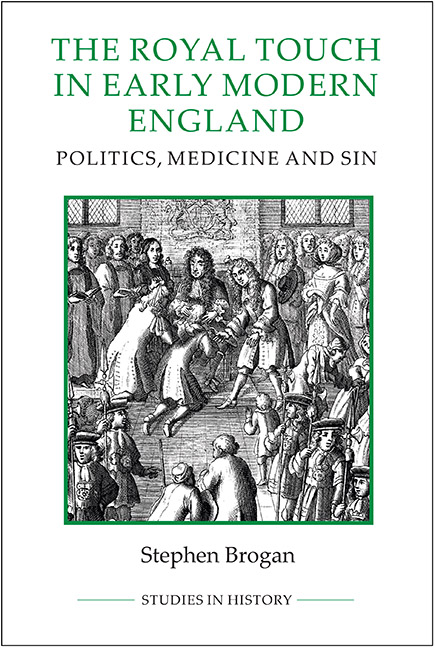Book contents
- Frontmatter
- Contents
- List of Illustrations
- List of Tables
- Dedication
- Acknowledgements
- Abbreviations
- Introduction
- 1 The origins and medieval history of the royal touch, 1000–1485
- 2 The Tudors: revival and reform of royal therapeutics, 1485–1603
- 3 The royal touch and the Stuart monarchy, 1603–1688
- 4 The ritual process of the royal touch, 1660–1688
- 5 The Restoration debate: the rise of ambivalence and scepticism, 1660–1688
- 6 The royal touch and the early English Enlightenment, 1689–1750
- Conclusion
- Bibliography
- Index
3 - The royal touch and the Stuart monarchy, 1603–1688
Published online by Cambridge University Press: 17 June 2021
- Frontmatter
- Contents
- List of Illustrations
- List of Tables
- Dedication
- Acknowledgements
- Abbreviations
- Introduction
- 1 The origins and medieval history of the royal touch, 1000–1485
- 2 The Tudors: revival and reform of royal therapeutics, 1485–1603
- 3 The royal touch and the Stuart monarchy, 1603–1688
- 4 The ritual process of the royal touch, 1660–1688
- 5 The Restoration debate: the rise of ambivalence and scepticism, 1660–1688
- 6 The royal touch and the early English Enlightenment, 1689–1750
- Conclusion
- Bibliography
- Index
Summary
The Stuarts touched greater numbers of people and with greater regularity than had any of their predecessors, meaning that, although the royal touch originated in the Middle Ages, in terms of its vitality it was primarily a seventeenth-century phenomenon. The ceremony was at its most popular during the Restoration, with Charles II touching an average of 4,000 people each year until the 1680s, when both he and James II administered some 6,000 a year. These huge figures are even more astonishing when it is recalled that between 1530 and 1532 Henry VIII is recorded as having touched just sixty-five scrofulous people. Did this mean that scrofula became more prevalent during the Stuart age, or that the Stuarts had greater pretensions to sacral monarchy than any of their forebears, or that the appeal of the royal touch greatly increased during the seventeenth century? Although scrofula was widespread in pre-modern Europe, whether its prevalence increased during the seventeenth century is not known; but even if it did, it is unlikely to have done so in proportion to the numbers that sought the royal touch. Whilst it is obviously the case that healing the sick in imitation of Christ could bolster royal authority, none of the political tracts that advocated absolutism discussed royal therapeutics. Furthermore, enthusiasm for the royal touch reached such levels that all the Stuart monarchs struggled to control the demand for it. The Stuarts put more effort into holding back and regulating the crowds of ill people than in promoting themselves as thaumaturgic sovereigns.
In order to understand the great upsurge in popularity of royal therapeutics its increased appeal to sick people must be privileged. The first seventeenth-century reforms of the ceremony that improved its credentials by making it more Protestant date from James VI and I's reign. Initially James had spoken against the practice but eventually he decided to touch for scrofula. The second set of reforms was Charles I's bureaucratic measures which sought to bring greater order to the royal touch, especially the healing calendar. Their effectiveness varied, so great was the demand for the touch. Order broke down during the Civil War, with the king sometimes touching without liturgy or gold; yet the appeal of his therapeutic touch did not diminish, for reasons that can be connected to the cult of Charles the Martyr.
- Type
- Chapter
- Information
- The Royal Touch in Early Modern EnglandPolitics, Medicine and Sin, pp. 67 - 119Publisher: Boydell & BrewerPrint publication year: 2015

